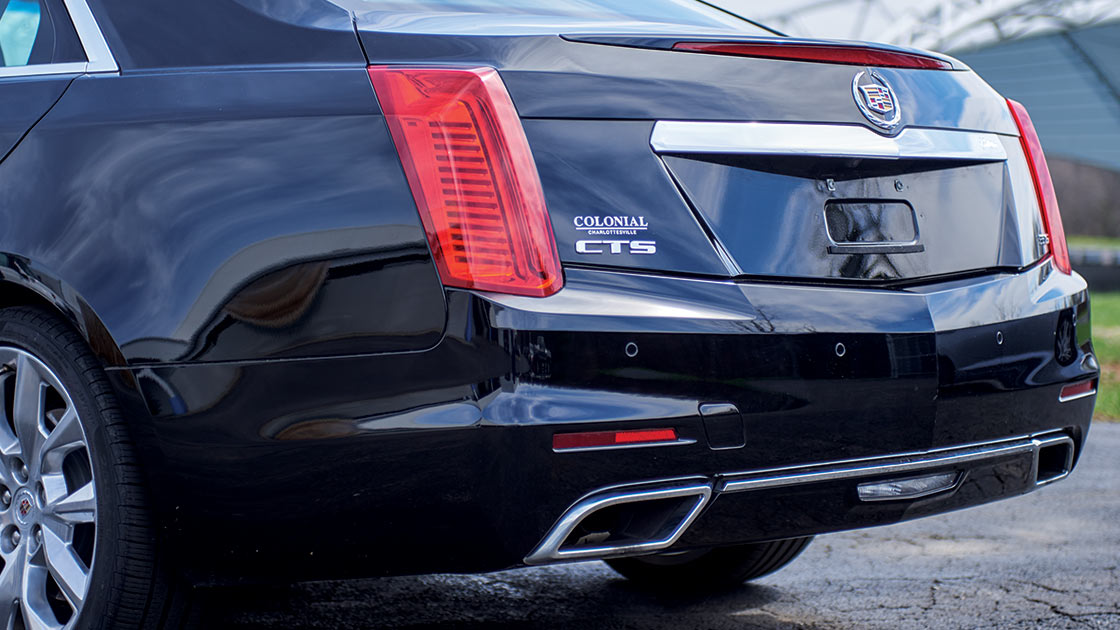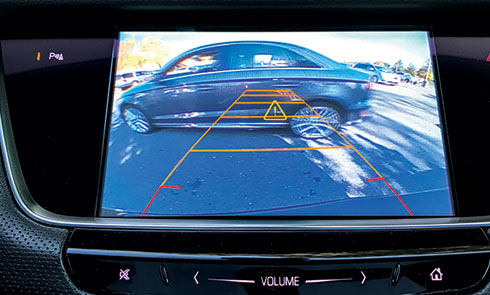Park assist helps drivers avoid backing crashes
February 22, 2018

Backing out of a parking space in a busy lot entails focus and precision — two things harried drivers may lack. Mix in other motorists preoccupied with crossing off their to-do lists, and fender-benders often result. New research from IIHS indicates that a rear automatic braking system bundled with rear parking sensors and a rearview camera can reduce backing crash-involvement rates by more than 75 percent, while a rear cross-traffic alert system alone can reduce them by more than 20 percent.
The two studies are the latest in a series of reports from IIHS and HLDI that show benefits for rear autobrake, rearview cameras and parking sensors (see "GM's rear autobrake reduces crashes," Aug. 23, 2017, and "Rearview cameras reduce police-reported backing crashes," Nov. 17, 2016).
"Even though backing up is a routine maneuver, there's a lot of information to process," says Jessica Cicchino, the study's author and the Institute's vice president for research. "Park-assist systems can help with this task if drivers can see what's in the camera display, heed the alerts and respond appropriately. Rear autobrake adds another level of safety because it doesn't rely on drivers to take action to avoid a crash."
In 2015, about 188,000 passenger vehicles in the U.S. were involved in backing crashes reported to police, accounting for 2 percent of all passenger vehicle crash involvements, data from the National Highway Traffic Safety Administration indicate. The agency only tracks crashes on public roadways, so counting parking lot and private driveway crashes would push the number higher.
Rearview cameras help drivers better see what is behind them when driving in reverse, and parking sensors issue warnings when the vehicle gets too close to another vehicle or object directly behind it. Rear cross-traffic alert warns drivers of approaching vehicles that might cross their path as they back up. Rear autobrake systems detect objects behind reversing vehicles and may automatically brake if, for example, drivers don't heed alerts to stop.
In her study on rear autobrake, rearview cameras and parking sensors, Cicchino looked at late-model General Motors cars and SUVs involved in backing crashes in 23 states during 2012–15. Vehicles included the Cadillac ATS (2013–15 models), CTS (2014–15), Escalade (2015), SRX and XTS (2013–15), as well as the Buick LaCrosse and Regal and the Chevrolet Impala, all 2014–15 models. The GM models studied could have had a rearview camera alone; parking sensors alone; rearview camera plus parking sensors; rear autobrake, rearview camera and parking sensors; or none of these features. Rear autobrake was only available on the Cadillacs. The study controlled for the presence of rear cross-traffic alert, which was on some vehicles with both the rearview camera and sensors and all vehicles with rear autobrake.
Automakers use an array of names for the driver assistance systems described here generically. GM uses the terms Rear Vision Camera, Rear Parking Assist and Rear Automatic Braking for the systems on the specific models IIHS studied. GM began using the term Reverse Automatic Braking with 2017 models.
Cicchino compared backing crash involvements per insured vehicle year of models with and without the featured technologies. An insured vehicle year is one vehicle insured for one year, two vehicles for six months each, etc. She used police reports to identify crashes in which study vehicles were traveling in reverse and vehicle identification numbers and backing feature information provided by GM to identify models with driver assistance systems. Cicchino used HLDI data on vehicle exposure and garaging location to control for rated driver age, gender, marital status, insurance risk level, state, calendar year and registered vehicle density. For each technology studied, she also controlled for the effects of the other backing systems on the vehicle.
Nearly two-thirds of the 640 crashes in the first study occurred in a parking lot or on private property. Seventy-one percent involved backing into a moving vehicle, while 21 percent involved hitting a parked vehicle. Only 5 percent of the crashes involved injuries.
Parking sensors alone reduced backing crash-involvement rates by 28 percent, and rearview cameras alone reduced them by 5 percent, but neither of these reductions was statistically significant. A previous IIHS report found that rearview cameras prevented an average of 1 in 6 police-reported backing crashes per insured vehicle year when looking at systems from four manufacturers.
The combination of a rearview camera and parking sensors reduced backing crash-involvement rates by 42 percent. Rear autobrake reduced backing crash rates by 62 percent beyond the effect for cameras and sensors. Taken together, vehicles with all three systems had 78 percent lower police-reported backing crash rates than vehicles with none of the systems.
"If all passenger vehicles had a rearview camera, parking sensors and rear autobrake systems that perform like the ones on these GM models, we could eliminate 3 in 4 backing crashes reported to police," Cicchino says.
For the second study, Cicchino included the GM models from the first analysis, plus the Chevrolet Suburban and Tahoe, and GMC Yukon, all 2015 SUVs, with optional rear cross-traffic alert. She added Mazda cars and SUVs with the feature, including the 3 and 6 (2014–16), CX-3 and CX-5 (2016), CX-9 (2014–15) and MX-5 Miata Convertible (2016). The study used data from 25 states on 1,044 police-reported backing crashes during 2012–15. (The Mazda analysis excluded 2012 data as the system was introduced on 2014 models.)
All GM vehicles with rear cross-traffic alert also had both the rearview camera and rear parking sensors. On the Mazdas, the rearview camera and rear cross-traffic alert were offered as bundled or separate options. The study controlled for the effects of the other park-assist systems on the vehicles.

When Cicchino averaged the effects between vehicles, she found that backing crash-involvement rates were 22 percent lower among vehicles with rear cross-traffic alert than ones without the feature. In two-vehicle crashes where the backing vehicle hit another one traveling in a perpendicular direction — the most relevant crashes to the technology — crash-involvement rates fell by 32 percent.
"Rear cross-traffic alert is a good complement to rearview cameras, parking sensors and rear autobrake," Cicchino says. "These technologies should help drivers feel more confident when backing up, especially when their view is obstructed by taller vehicles or garage pillars."
Both studies bolster the findings of a recent HLDI analysis of the frequency of insurance claims among GM models equipped with park assist. Claim frequency is the number of claims filed relative to the number of insured vehicle years. HLDI found a 26 percent reduction in the frequency of claims under property damage liability coverage and a 13 percent reduction in the frequency of claims under collision coverage for Cadillacs equipped with rear autobrake compared with Cadillacs without the feature. HLDI has found benefits for parking sensors from other manufacturers but mixed results for other park-assist systems.
An important difference between HLDI's analysis and Cicchino's studies is that backing crashes can be identified in police reports but not in insurance data. Narrowing the analysis to just the crashes that rear autobrake is designed to address allows for a better picture of how the technology is performing in the real world.
General Motors park assist systems, percent difference in police-reported backing crash rates
General Motors and Mazda rear cross-traffic alert systems, percent difference in police-reported backing crash rates